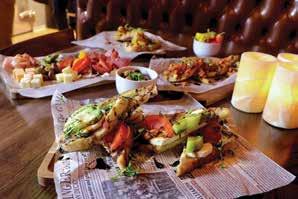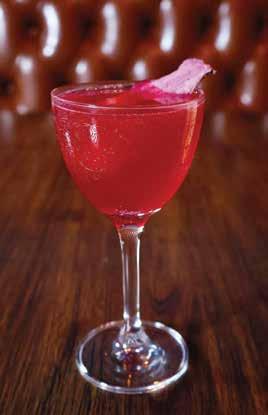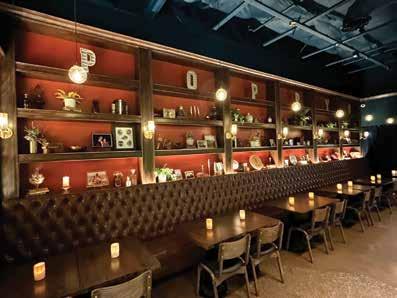












I smile every time I revisit this photo of this timeless primary bedroom. Our client loves color and texture, and you can see why. This is a perfect example of how fun my career is. I honor that it’s the client’s home and their sacred space.
Everything is custom! The woven leather headboard was inspired by an ad for a designer handbag. We meticulously proportioned the width of the leather bands for the king-size bed, using both the suede side and the smooth side of the leather for rich, added texture. We ran the weave on a diagonal, and hand-forged twisted iron frames the headboard, creating a sophisticated focal point.
The harmonious balance of the terracotta red and brown is artfully blended in the draperies and front accent pillows. We accented the terracotta in the writing desk and repeated it in the luxurious Tibetan lamb’s wool on the stools at the foot of the bed.
Notice the details of the custom bedding: We used a contrasting flange of brown suede against the warm camel of the coverlet. This rich brown repeats the color of the leather bed, creating visual cohesion throughout the space. For the back accent pillows, we used terracotta handwoven pillows with texture. A fun tin flower over the desk, picture frames of family and a horn lamp add the perfect finishing touches.




THIRD THURSDAY ART NIGHT THURSDAY, APRIL 17 FROM 4 TO 7 PM

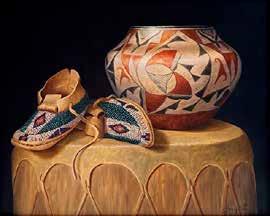
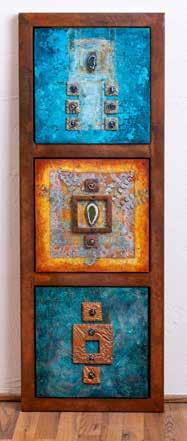
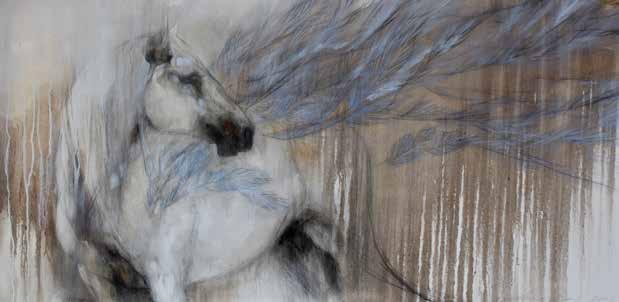

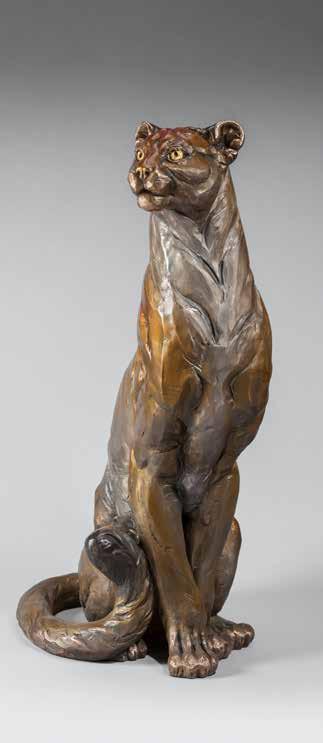





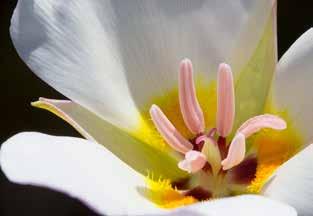

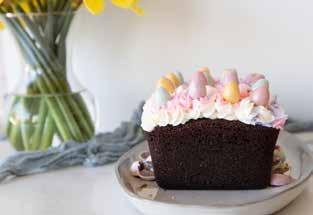




Publisher Shelly Spence
Managing Editor
Joseph J. Airdo
Graphic Designer
Meaghan Mitchell
Contributing Writers
Joseph J. Airdo
Francine Coles
Shannon Severson
Photographers
Francine Coles
Loralei Lazurek
Advertising Sales
Cindi Calcinari
860-966-3271 cindi@imagesaz.com
Images Arizona P.O. Box 1416
Carefree, AZ. 85377 623-341-8221 shelly@imagesaz.com imagesarizona.com

AAs spring takes full bloom across our desert landscape, April invites us to look closer at the extraordinary that exists within the ordinary. This month’s issue of Images Arizona celebrates the richness of detail and craftsmanship that make our community so vibrant.
Coffee enthusiasts will delight in our opening story, “Liquid Artistry,” which takes you on a flavorful journey through the North Valley’s most innovative coffee destinations. These signature creations are more than just beverages — they’re carefully composed expressions of artistry that reflect the passion and creativity of the establishments that serve them.
Our cover story, “Turning Point,” introduces you to artist Brian Lensink, whose award-winning wood-turned creations showcase both technical mastery and artistic vision. His journey from a career serving individuals with developmental disabilities to becoming a master woodturner reminds us that artistic callings can emerge at any stage of life — and with spectacular results. Don’t miss his upcoming showcase at Grace Renee Gallery in Carefree.
In celebration of Earth Day, our photo essay, “The Hidden Universe,” showcases the breathtaking macro photography of Paul Gill. Through his lens, we witness the intricate architecture of native insects, the jewel-like quality of morning dew and the abstract patterns hidden within desert flora — all reminders of the complexity and fragility of ecosystems that depend on our protection.
As you explore these pages, I hope you’ll be inspired to look closer at the world around you, appreciating both the grand vistas and minute details that make Arizona such a magical place to call home.
Cheers,
Shelly Spence Publisher, Images Arizona




Step into a world where exotic woods transform into mesmerizing works of art at Grace Renee Gallery’s exhibition featuring master woodturner Brian Lensink, who will be present to discuss his techniques and inspiration. From intricate “basket illusion” pieces inspired by Native American pottery to innovative segmented turnings showcasing dozens of exotic wood varieties, Lensink’s creations captivate with their technical precision and artistic vision.
Thursday, April 17
Wine & appetizers 4–7 p.m.
Grace Renee Gallery
Historic Spanish Village | 7212 E. Ho Hum Rd. # 7 | Carefree, AZ
Hours: Tue.–Sat. 10 a.m.–5 p.m. By appointment Sun. and Mon.
GraceReneeGallery.com | 480.575.8080


Writer Joseph J. Airdo
IIn the hands of the North Valley’s most innovative coffee artisans, the humble coffee bean transforms into spectacular liquid canvases. These signature creations — meticulously crafted, boldly imagined and thoughtfully presented — reveal as much about the establishments that serve them as any mission statement ever could.
Behind each distinctive beverage lies a philosophy: one cafe’s commitment to community development expressed through locally sourced ingredients; another’s dedication to scientific precision manifested in the perfect balance of flavors; a third’s reverence for tradition reimagined through contemporary techniques.
This spring, Images Arizona invites you to experience these liquid masterpieces firsthand — each one offering a sip of the passion, creativity and craftsmanship that define our region’s most sophisticated coffee destinations. These aren’t merely drinks but rather carefully composed expressions of artistry that happen to come in a cup.
These aren’t merely drinks but rather carefully composed expressions of artistry that happen to come in a cup.
Masters of the Craft
Amped Coffee Co.
3434 W. Anthem Way, Suite 102 // Anthem // ampedcoffeeco.com
Carefree Coffee Roastery
7171 E. Cave Creek Road, Suite T Carefree // carefreecoffeeroastery.com
Cartel Roasting Co.
10625 N. Tatum Blvd., Suite 104 21001 N. Tatum Blvd., Suite 20 Phoenix // cartelroasting.co
Elevate Coffee Co.
2530 W. Happy Valley Road, Suite 1273 Phoenix // elevatecoffee.com
Infusion Coffee & Tea
13212 N. Cave Creek Road Phoenix // infusioncoffeetea.com
Nephews Coffee
20049 N. 24th Way Phoenix // nephewscoffee.com
The Village Coffee & Creperie
7100 E. Cave Creek Road, Suite 138 Cave Creek // thevillagecoffeshop.com


At Anthem’s beloved Amped Coffee Co., the signature French Toast Latte stands as a testament to creative coffee craftsmanship. This decadent creation infuses espresso with a harmonious blend of brown sugar, cinnamon, maple and vanilla syrup, transforming a beloved breakfast classic into a sophisticated beverage experience.
The French Toast Latte is just one star in a trio of signature offerings that showcase Amped’s range. Its health-conscious Protein Powerhouse Latte delivers 30 grams of protein in vanilla or chocolate variations, while its staple Amped Caramel Macchiato offers a perfectly balanced everyday indulgence.
This thoughtful approach to beverage creation mirrors Amped’s overall philosophy — offering experiences that range from indulgent to practical, all executed with artisanal care. The warm industrial atmosphere, featuring numerous repurposed design elements, provides a fitting backdrop for enjoying these crafted beverages.
What truly distinguishes Amped, however, is how its signature drinks embody its community values.
“Supporting small-business owners and local suppliers is one of our core values, which is why we source the majority of our supplies from these establishments,” explains owner Jeanine Furse.
This commitment extends to its innovative First Responder Gift Card program, where community donations are matched dollar for dollar, providing complimentary beverages to those who serve.
The result is more than just exceptional coffee — it’s a gathering place where the signature beverages serve as the centerpiece for connection, whether in the community hub where people gather with friends, the meeting spaces for colleagues, or the dedicated work/study loft that offers a quiet area perfect for concentration.

The interplay of chocolate, honey, cayenne and superfood spices creates the exceptional Aztec Latte at Carefree Coffee Roastery, a signature beverage that exemplifies its approach to coffee as both sensory art and culinary craft.
“Just a perfect hint of heat makes this espresso-based drink a craving for your palate,” owner Lars Hesse describes.
What elevates this remarkable creation beyond its enticing flavor profile is the meticulously sourced foundation beneath it. Since 2015, Carefree Coffee Roastery has built its reputation on an uncompromising approach to specialty coffee bean selection and preparation.
“Carefree Coffee Roastery purchases, roasts and brews only the finest specialty coffees from small farms throughout the world’s most prestigious growing regions,” Hesse explains. “We strive to deliver consistently high quality in a warm, welcoming, locally oriented environment.”
The Aztec Latte’s distinctive character comes not just from its innovative flavor combination but from the roastery’s proprietary approach to coffee preparation, which includes house-crafted syrups and sauces that enhance rather than mask the coffee’s inherent qualities.
“At Carefree Coffee Roastery, we drum-micro roast all our premium green beans to develop their fullest flavor profile,” Hesse shares. “This precise process reduces the natural acidity found in coffee beans by carefully controlling both the roasting temperature and duration. The result? A perfect cup with rich, complex flavors and an enticing aroma that captivates our customers from the first sip.”
This signature beverage represents not just a drink but the roastery’s broader mission of community engagement. While serving exceptional coffee creations, Carefree Coffee Roastery actively supports local nonprofits through programs like the FMW Farms egg donation initiative, regularly contributes gift baskets to charity events, and donates coffee to veterans gatherings and church events throughout the area.

The Espresso Tonic at Cartel Roasting Co. represents a bold departure from conventional coffee expectations — a crystalclear expression of its commitment to showcasing coffee’s natural complexity without masking it behind syrups or milk.
“We combine our carefully crafted espresso with grapefruit tonic water, even pulling the espresso shot over a dried lime to further accentuate the citrus notes,” explains Jesse Pangburn, president and COO. “With no milk or syrup in the drink, it’s a light, refreshing coffee option that we enjoy sipping year-round.”
This transparent approach to beverage creation mirrors Cartel’s broader philosophy of clarity and authenticity. Since its founding by Jason and Amy Silberschlag in 2008, Cartel has expanded from a single Tempe location to 13 cafes — including two in North Phoenix — while maintaining an unwavering dedication to its core values.
“From day one, our mission has been to foster community through coffee,” Pangburn says. “As we grow and evolve as a business, our top priorities remain consistent: coffee quality, sourcing transparency and supporting our team of passionate people.”
The Espresso Tonic’s unobscured presentation perfectly reflects Cartel’s commitment to transparency throughout its supply chain.
“Traceability, quality and sustainability serve as the three pillars of our coffee buying and roasting process,” Pangburn notes. “For every single-origin coffee we offer, we provide detailed information including the farm name, bean varietal, processing method and elevation where it was grown.”
Beyond exceptional beverages, Cartel’s Give Back Program showcases its community commitment. Each quarter, it partners with a local organization, featuring its name on special coffee labels and donating 10% of sales directly to the cause.

The signature Caramel Macchiato at Elevate Coffee Co. in North Phoenix achieves coffee’s elusive perfect balance — a harmonious quartet of rich espresso, velvety milk, sweet caramel and smooth vanilla that creates an experience greater than the sum of its parts.
This meticulously crafted beverage serves as the cornerstone of Elevate’s menu, embodying its philosophy that exceptional coffee requires both precision and artistry. While the Caramel Macchiato provides a consistent foundation, the cafe’s creative spirit shines through its rotating seasonal offerings.
“Beyond this staple, we take particular pride in our rotating seasonal offerings — from our warming fall flavors collection to festive holiday drinks that capture the spirit of the season,” notes Michael Sawyer, marketing manager. “Summer brings our popular Barista Faves series, showcasing creative, handcrafted beverages designed by our talented team members.”
The signature Caramel Macchiato and these seasonal creations represent more than just beverages — they reflect Elevate’s broader mission of creating connections through quality experiences.
“Beyond our menu, Elevate Coffee Co. is fundamentally about community and craftsmanship,” Sawyer shares. “We’re passionate about creating a welcoming space where people can genuinely connect — whether they’re meeting friends for a casual conversation or seeking a quiet moment of inspiration.”
This focus on craftsmanship extends to its roasting process, which serves as the foundation for its signature beverages.
“We take particular pride in roasting all our coffee beans in-house, which allows us to ensure exceptional quality and freshness in every cup we serve,” Sawyer adds.
This in-house roasting practice ensures that its signature Caramel Macchiato and seasonal specialties begin with a superior foundation — an approach that elevates every aspect of the coffee experience from bean to cup.
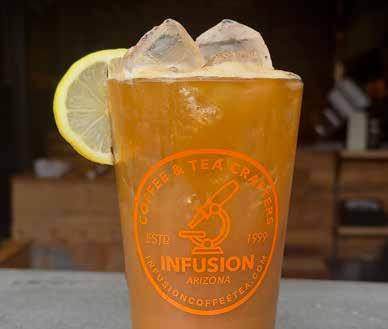
At Infusion Coffee & Tea, the Bee’s Knees and The Sol signature beverages represent a creative approach to flavor composition that transforms coffee into extraordinary sensory experiences.
The Bee’s Knees offers a refreshing, effervescent profile with espresso shaken vigorously with honey and lemon, then crowned with sparkling water. Its counterpart, The Sol, takes a more nuanced approach with a double shot of espresso cascading over honey and housemade orange blossom syrup, finished with a splash of orange juice that brightens the composition.
“If the notes of the coffee are just one step toward finding something you’ll love, we also have signature flavor pairings within our classic staples and seasonal menus,” explains Ramsey Tucker, public relations coordinator.
“What sets Infusion apart is our unique offerings, from our expertly crafted flavor combinations to the exceptional coffee that defines our signature drinks. With over 15 coffee varieties, many of which are sourced through direct trade, we highlight these flavors through our slow bar brewing process.”
Its innovative approach extends to its barrel series, where it ferments green coffee in barrels from local breweries before roasting, exposing rich flavor notes without any alcohol. This commitment to experimentation is matched by its ethical sourcing practices, including relationships with producers like former oncologist and radiologist Mauricio Sattah, who applies his scientific expertise to producing competition-level beans.
The Bee's Knees and The Sol serve as liquid ambassadors for Infusion’s decade-long presence in the community, with locations in Tempe, Queen Creek and North Phoenix.
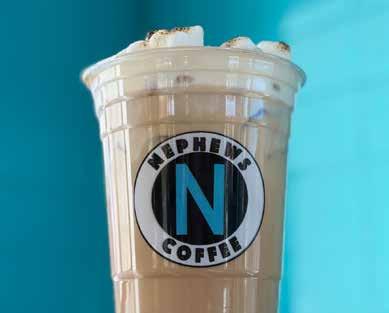
The drive-thru window at Nephews Coffee in North Phoenix reveals something unexpected — signature beverages that rival any sit-down cafe in their creativity and craftsmanship. The Gibru and Benju stand as liquid proof that convenience need not compromise quality.
The Gibru transforms the beloved cinnamon roll into liquid form — a white mocha infused with warm cinnamon notes and finished with a perfect dusting of the spice. Its companion creation, the Benju, offers a more complex sensory experience with toasted marshmallow and almond flavors, crowned with a house-made toasted marshmallow soft top and garnished with freshly toasted marshmallows.
These distinctive beverages represent Nephews’ philosophy that exceptional coffee should be both accessible and artisanal. Its drive-thru model democratizes specialty coffee without sacrificing quality.
“We truly care about the quality of our drinks and source only the best ingredients for our coffee,” explains cofounder Juan Urias. “We wanted to create a delicious alternative in the area that features 100% Arabica beans, organic cold brew, and the most natural flavored syrups available.”
The signature beverages reflect Nephews’ commitment to local sourcing and community support. It sources chai from Maya Chai in Tucson, uses locally roasted coffee beans and serves empanadas homemade in Mesa. This locally focused approach extends to its community engagement, where it participates in raffles and donates coffee to nonprofit events.
“The local community means everything to us,” Urias emphasizes. “Our goal has always been to serve the community both through quality offerings and meaningful participation in local causes.”


At The Village Coffee & Creperie in Cave Creek, the Toasted Marshmallow Latte offers a playful yet sophisticated take on coffee indulgence — a signature beverage that captures the establishment’s blend of whimsy and craftsmanship.
This distinctive creation features toasted marshmallow syrup, topped with mini marshmallows and homemade whipped cream, creating a beverage that’s both visually striking and delightfully indulgent. The coffee’s natural richness provides the perfect foundation for the sweet, toasty notes of the marshmallow elements.
“All our coffee is made with fresh, organic, locally roasted espresso beans from Roastery of Cave Creek,” explains owner Marina Matatov. “We take pride and joy in creating all our handcrafted beverages, adding a little bit of love into everything we serve.”
This commitment to quality ingredients extends throughout its coffee program, which features everything from meticulously crafted Americanos and cappuccinos to chai macchiatos. Each beverage serves as the perfect companion to its extensive crepe menu, which has made the establishment a beloved community fixture since it opened in 2010.
“It’s all been a true blessing, with the most incredible customers and local support making our journey possible,” reflects Matatov, who was born in Russia and came to the United States in 1995 before establishing what has become a Cave Creek institution.
The warm, welcoming atmosphere and attention to detail in both its signature beverages and crepe offerings have kept loyal customers returning for 15 years, making The Village Coffee & Creperie an essential part of many morning routines.


Writer Joseph J. Airdo

Through April 30
‘BUBBLE PLANET’
This immersive art experience features 10 themed environments celebrating bubbles and imagination. Visitors journey through LED-lit spaces, infinity rooms, virtual reality stations and interactive installations including a bubble bath pit and giant bubble chamber. The hour-long experience includes hands-on activities and photo opportunities. $22.90; children 4–16 $17.90; 3 and under free. See website for times. Arizona Mills Mall, 5000 S. Arizona Mills Circle, Tempe. bubble-planet.com
‘CHURCHILL’
The Phoenix Theatre Company presents this one-man show set in 1963, as Winston Churchill reflects on his life following his honorary U.S. citizenship. The statesman shares memories of war, leadership and the influential women in his life, from wife Clementine to Queen Elizabeth II. $59+. See website for showtimes. Judith Hardes Theatre at The Phoenix Theatre Company, 1825 N. Central Ave., Phoenix. phoenixtheatre.com
‘THE RAINMAKER’
Don Bluth Front Row Theatre presents N. Richard Nash’s classic play about a drought-stricken Western town and the arrival of a charismatic stranger who promises rain. This touching romantic comedy explores themes of faith, hope and self-discovery. $30+; senior, student, military and youth discounts available. See website for showtimes. Don Bluth Front Row Theatre, 8989 E. Via Linda, Suite 118, Scottsdale. 480-314-0841; donbluthfrontrowtheatre.com
‘THERE IS NO PLANET B’
Scottsdale Arts Learning & Innovation presents works by Arizona-based members of ecoartspace addressing environmental issues. The exhibition features photography, drawings, paintings, sculpture and installations that explore humanity’s relationship with the natural world. Free. Tuesday–Saturday 11 a.m.–6 p.m., Sunday Noon–5 p.m. Center Space gallery, Scottsdale Center for the Performing Arts, 7380 E. Second St., Scottsdale. scottsdaleartslearning.org
April 2–6
The Southwest’s largest motorcycle event features hundreds of vendors, builders, dealers and manufacturers in the PowerYard. Daily activities include stunt shows, contests, live entertainment and bike shows. Nightly concerts in the RockYard feature Five Finger Death Punch, Mudvayne, Stone Temple Pilots and Jackyl. $24+; five-day Rally Pass available. Noon–6 p.m. WestWorld of Scottsdale, 16601 N. Pima Road, Scottsdale. 480-6448191; azbikeweek.com
April 3–Aug. 3
‘EMBROIDERED WITH PAIN’
Scottsdale Arts Learning & Innovation presents this powerful exhibition using traditional Ukrainian hand embroidery to encode stories of sexual violence survivors during Russia’s invasion of Ukraine. The display features five “rushnyks” (traditional cloths) with ornamental
symbols representing fictional women based on real survivors’ experiences. An interactive website allows visitors to decipher the encoded narratives. Free. Tuesday–Saturday 11 a.m.–6 p.m., Sunday Noon–5 p.m. ArtReach Space Gallery, Scottsdale Center for the Performing Arts, 7380 E. Second St., Scottsdale. scottsdaleartslearning.org
The Heard Museum presents the opening of “Bob Haozous — A Retrospective View,” showcasing six decades of work by the Warm Springs Chiricahua Apache artist. The comprehensive exhibition features sculpture, painting, prints and jewelry, highlighting Haozous’ significant contribution to contemporary Indigenous art. Free. 5–9 p.m. Heard Museum, 2301 N. Central Ave., Phoenix. 602-252-8840; heard.org
The Phoenix Symphony Chorus, led by Dr. Thomas Bookhout, presents Morten Lauridsen’s masterpiece “Lux Aeterna” alongside works by Samuel Barber, Ola Gjeilo and Mack Wilberg. This onenight-only performance explores the theme of light through various choral compositions. $35+. 2 p.m. and 7:30 p.m. Pinnacle Presbyterian Church, 25150 N. Pima Road, Scottsdale. 602495-1999; phoenixsymphony.org
April 4–6
MIM’S 15TH ANNIVERSARY CELEBRATION
The world’s largest musical instrument museum marks its milestone with three days of special activities and performances. Features demonstrations of the Robjohn pipe organ and octobasse, an anniversary scavenger hunt, and at least 15 different activities daily showcasing local and debut musicians. $10+; children 3 and
under free. 9 a.m.–5 p.m. The Musical Instrument Museum, 4725 E. Mayo Blvd., Phoenix. 480-478-6000; mim.org
April 4–13
MARICOPA COUNTY FAIR
This annual springtime tradition showcases agricultural exhibits, livestock competitions, carnival rides, games, concerts, fair food and more. The seven-day event, closed Monday through Wednesday, features competitive exhibits in categories ranging from fine arts to culinary arts, plus 4-H and FFA youth exhibitions. Visitors can experience animal exhibits, entertainment and various daily specials throughout the fair’s run. See website for admission prices and hours. Arizona State Fairgrounds, 1826 W. McDowell Road, Phoenix. 602-2520717; maricopacountyfair.org
April 4–20
‘STEEL MAGNOLIAS’
Scottsdale Desert Stages Theatre presents this beloved play set in Truvy’s beauty salon in Chinquapin, Louisiana. The story follows a group of women as they navigate life’s joys and tragedies together. See website for ticket prices and showtimes. Actor’s Cafe at Scottsdale Desert Stages Theatre, Fashion Square, 7014 E. Camelback Road, Suite 0586, Scottsdale. desertstages.org
5
The Heard Museum hosts this gathering of carvers showcasing and selling traditional Hopi katsina dolls. Meet the artists and learn about the cultural significance and artistry behind these carved representations of katsina spirits. Museum admission: $20; seniors $17; students $9; children 6–17 $7.50; members and children under 6 free. 10 a.m.–4 p.m. Heard Museum, 2301 N. Central Ave., Phoenix. 602252-8840; heard.org
April 5
‘THE PIRATES OF PENZANCE’
Musical Theatre Artists of Arizona presents a concert version of Gilbert and Sullivan’s beloved operetta. This community-based production features nearly 100 local performers, including a full orchestra and chorus, bringing the Broadway cast recording to life. $20$40. 7 p.m. All Saints Lutheran Church, 15649 N. Seventh St., Phoenix. mtaa.org
April 5 and May 3
SCOTTSDALE MOTORSPORTS GATHERING
Scuderia Southwest presents this curated display of members’ rare and high-performance vehicles. Free for spectators. 7–10 a.m. Market Street at DC Ranch, 20789 N. Pima Road, Scottsdale. scuderiasouthwest.com
April 5–6
PHOENIX BONSAI SOCIETY ANNUAL SHOW
The Phoenix Bonsai Society presents its annual exhibition featuring artistic miniature trees cultivated by local enthusiasts. The event includes demonstrations, critiques and expert guidance about this ancient Japanese art form. Visitors can explore diverse bonsai varieties while learning about cultivation techniques and the cultural significance of these living sculptures. Free. Saturday 9 a.m.–4 p.m., Sunday 10 a.m.–3 p.m. Valley Garden Center, 1809 N. 15th Ave., Phoenix. phoenixbonsai.com
April 6
‘THE GREAT SCHEHERAZADE’
The Scottsdale Philharmonic performs Rimsky-Korsakov’s mesmerizing “Scheherazade,” Bizet’s passionate “Carmen Suite No. 1,” and Gliere’s spirited “Russian Sailors Dance.” Features soprano Melissa Solomon performing Puccini’s “Un Bel Di.” $20+; free for students and armed services/ veterans. 4 p.m. La Casa de Cristo Lutheran Church, 6300 E. Bell Road, Scottsdale. scottsdalephilharmonic.com
Writer Joseph J. Airdo
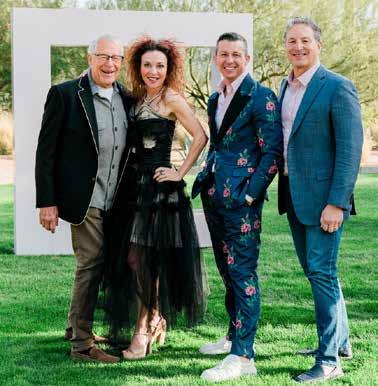
April 11
THE PARTY IN THE GARDEN
Photo by Airi Katsuta
Phoenix Art Museum presents its annual gala, featuring a night of “rock ‘n’ roll romance” inspired by the Phoenix premiere of “The World of Anna Sui.” The exhibition showcases about 100 ensembles from the award-winning fashion designer’s archive. The evening includes a cocktail hour and elegant dinner under the stars in the Dorrance Sculpture Garden, followed by The afterpARTy with dancing and desserts in a surprise museum location. $165+. 7 p.m. Phoenix Art Museum, 1625 N. Central Ave., Phoenix. 602-257-2101; phxart.org/party-in-the-garden
April 10–July 15
‘SUPERDELIC PSYCHONATURAL’
Scottsdale Public Art presents this vibrant exhibition featuring collaborating artists Lex Gjurasic and Ners Neonlumberjack, who express their reverence for nature through intensely hued paintings and sculptures. The show includes works composed of natural materials such as sticks, stones, bones and botanicals, plus four augmented reality pieces accessible via the Hoverlay app. A 10-foot silk painting suspended from the library rafters serves as a centerpiece. Free. Civic Center Public Gallery, Scottsdale Civic Center Library, 3839 N. Drinkwater Blvd., Scottsdale. scottsdalepublicart.org
April 12
ALPIOS AT TROON CARS & COFFEE
Alpios at Troon hosts a monthly gathering featuring diverse vehicles and charitable initiatives benefiting St. Vincent de Paul. Complimentary coffee and doughnut holes; breakfast burritos available for donation. Free. 6–9 a.m. Alpios at Troon, 10452 E. Jomax Road, Scottsdale. alpiosattroon.com
April 12
THE ORIGINAL TASTE
Executive Council 70 presents its 52nd annual formal food and wine event benefiting more than 100 children’s charities. The evening features tastings from more than 20 premier Valley restaurants, including Pyro, STK and Kasai Japanese Steakhouse, plus craft cocktails and wine. Entertainment includes DJ Silver and a surprise country music act. The formal affair includes a red carpet entrance and custom hat-making station. $175+. 7–11 p.m. Scottsdale Civic Center, 7380 E. Second St., Scottsdale. ec70phx.com/original-taste
April 12–13
‘AIDA’
Arizona Opera presents Verdi’s grand opera about forbidden love amid political intrigue in ancient Egypt. This visually arresting, projection-based concert production marks the opera’s return to Arizona Opera after more than a decade. See website for ticket prices. Saturday 7:30 p.m., Sunday 2 p.m. Symphony Hall, 75 N. Second St., Phoenix. 602-266-7464; azopera.org
April 17
BRIAN LENSINK WOODTURNING SHOWCASE
Step into a world where exotic woods transform into mesmerizing works of art at Grace Renee Gallery’s exhibition featuring master woodturner Brian Lensink, who will be present to discuss his techniques and inspiration. From intricate “basket illusion” pieces inspired by Native American pottery to innovative segmented
turnings showcasing dozens of exotic wood varieties, Lensink’s creations captivate with their technical precision and artistic vision. Free. 4–7 p.m. Grace Renee Gallery, Historic Spanish Village, 7212 E. Ho Hum Road, Carefree. 480575-8080; gracereneegallery.com
Scottsdale Quarter presents its annual Easter celebration featuring a familyfriendly scavenger hunt throughout the shopping center. Children follow a trail of colored eggs to discover the secret location of a bag full of treats. The event includes live music, crafts, face painting and balloon twisting, with appearances by the Easter Bunny. $5. 11 a.m.–2 p.m. Scottsdale Quarter, 15059 N. Scottsdale Road, Scottsdale. scottsdalequarter.com
Penske Automall hosts a long-running monthly show featuring 75–125 vehicles, from classics to exotics. Free. 8–10 a.m. Penske Racing Museum, 7191 E. Chauncey Lane, Phoenix. penskeautomall.com
This community festival celebrates North Phoenix with local vendors, food trucks and live entertainment. The family-friendly event includes mini golf, face painting, a foam party and activities with the Arizona Rattlers. Benefits Put On The Cape Foundation. Free admission and parking. 9 a.m.–2 p.m. Paradise Valley Community College, 18401 N. 32nd St., Phoenix. valleypalooza.com

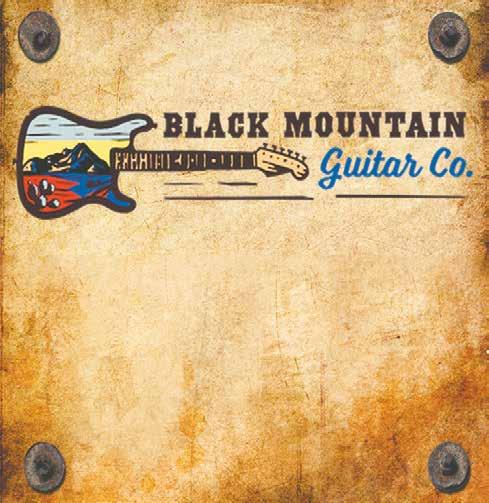

Writer Joseph J. Airdo

April 25–27
SEDONA VISUAL ARTISTS’ COALITION OPEN STUDIOS TOUR
This self-guided tour features 55 artists across the Verde Valley working in various media including glass, ceramics, sculpture, jewelry and painting. Visitors can meet artists in their studios, watch demonstrations and purchase artwork directly from creators. Enter to win a $250 gift certificate. Free. 10 a.m.–5 p.m. Various locations throughout Sedona and the Verde Valley. 503-789-4437; sedonaartistscoalition.org
April 19–May 4
‘BOB & JEAN: A LOVE STORY’
Arizona Theatre Company presents the world premiere of this poignant new play by Tony and Pulitzer Prizewinning playwright Robert Schenkkan. Based on recently discovered correspondence between the playwright’s parents during World War II, the production offers a deeply personal glimpse into their relationship amid wartime turmoil. $33+. See website for showtimes. Tempe Center for the Arts, 700 W. Rio Salado Parkway, Tempe. 833-282-7328; atc.org
April 23–June 22
‘FORBIDDEN BROADWAY: THE NEXT GENERATION’
The Phoenix Theatre Company presents this satirical revue that playfully skewers Broadway’s biggest hits and theatrical conventions. The show features clever parodies, spot-on impersonations and witty commentary on the world of musical theater. $59+. See website for showtimes. Judith Hardes Theatre at The Phoenix Theatre Company, 1825 N. Central Ave., Phoenix. phoenixtheatre.com
April 25–27
JUNK IN THE TRUNK VINTAGE MARKET
More than 160 vendors showcase vintage treasures, artisanal creations and handcrafted finds at this popular market. Features antiques, vintage fashion, jewelry, furniture and home decor, plus live music and food vendors. $10+; see website for ticket options and discounts. Friday VIP event 4–9 p.m., Saturday 9 a.m.–4 p.m., Sunday 10 a.m.–3 p.m. WestWorld of Scottsdale, 16601 N. Pima Road, Scottsdale. $10 parking. junkinthetrunkvintagemarket.com
April 26
ROSIE’S HOUSE OVATION GALA
This annual fundraiser supports one of the country’s largest free music education programs, serving youth from financially disadvantaged families. The evening features performances by Rosie’s House students, silent and live auctions, and celebration with more than 300 supporters. The formal event raises funds to provide high-quality music education to more than 650 youth annually. See website for price and time. The Camby, Autograph Collection, 2401 E. Camelback Road, Phoenix. rosieshouse.org/ovationgala
April 26
SCOTTSDALE JAZZ FESTIVAL
The 14th annual festival celebrates International Jazz Day with performances by Richard Elliot and Rick Braun (RnR), Dan Pinson’s All-Star Band, Carlos Rivas Y Mex-sal
featuring Luisito Rosario, and Nayo Jones. This year’s event pays tribute to the late Quincy Jones. The festival features diverse jazz styles in an outdoor setting. See website for ticket prices and schedule. Scottsdale Civic Center, 7380 E. Second St., Scottsdale. 480-499-8587; scottsdalejazzfest.org
April 26
TOY BARN CARS & COFFEE
Monthly gathering featuring luxury and exotic cars, gourmet refreshments and facility tours. Free. 7–10 a.m. The Toy Barn, 4504 E. Lone Mountain Road, Cave Creek. toybarnstorage.com
April 26–27
‘CAROUSEL, A CONCERT’
Arizona Musicfest celebrates the beloved musical’s 80th anniversary with Broadway stars Erica Spyres and James Snyder. The 45-piece Musicfest Pops Ensemble performs Rodgers & Hammerstein’s original orchestrations of favorites including “If I Loved You” and “You’ll Never Walk Alone.” $69+. Saturday 2 p.m. and 7:30 p.m., Sunday 2 p.m. Herberger Theater Center, 222 E. Monroe St., Phoenix. 602-252-8497; herbergertheater.org
April 27
HOLOCAUST REMEMBRANCE DAY COMMEMORATION
Phoenix Holocaust Association presents its annual Yom HaShoah observance marking the 80th anniversary of the end of World War II and the liberation of Holocaust survivors. The ceremony includes a procession of local survivors, a candle-lighting remembering the 6 million Jews murdered, a keynote address, survivor testimony, and musical performances including works by composers persecuted by the Nazis. The event follows The Phoenix Symphony’s 2 p.m. performance of Beethoven’s Ninth Symphony conducted by Tito Muñoz. Free; concert tickets not required for commemoration. 5 p.m. Symphony Hall, 75 N. Second St., Phoenix. phxha.com/remember
The Women’s Orchestra of Arizona presents its annual spring concert featuring Berlioz’s “Roman Carnival Overture” and Beethoven’s Symphony No. 7. Admission is by donation. 3 p.m. North Scottsdale United Methodist Church, 11735 N. Scottsdale Road, Scottsdale. womens-orchestra-arizona.org
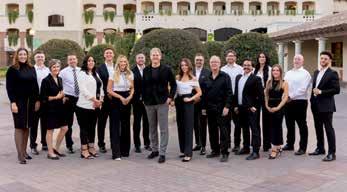
Writer Joseph J. Airdo
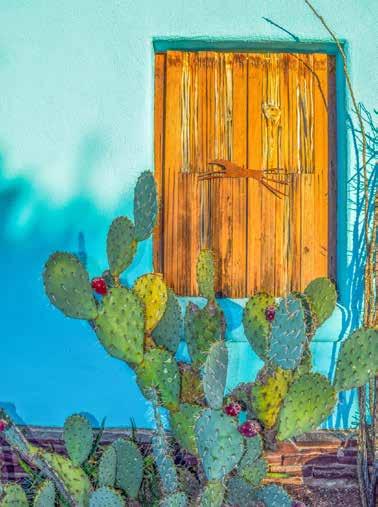
This curated art and fine-craft fair showcases premier state and regional artists in the heart of Old Town Cottonwood. Located within the Verde Valley American Viticultural Area, the event complements the area’s thriving wine culture with booths situated just steps from numerous tasting rooms, restaurants and galleries. Organized by Jerome-based artists John and Lauri Maeder, the quarterly event features artists selected through a rigorous process to ensure highquality, original work across various mediums. Free admission. Friday–Saturday 10 a.m.–6 p.m., Sunday 10 a.m.–5 p.m. Old Town Activity Park, 187 E. Pima St., Cottonwood. artists-village.com
‘ALL BALANCHINE’
Ballet Arizona presents three ballets by George Balanchine: “Walpurgisnacht,” “Scotch Symphony” and “Western Symphony.” The Phoenix Symphony provides live music for this celebration of the father of American ballet. See website for ticket prices and showtimes. Symphony Hall, 75 N. Second St., Phoenix. 602-381-1096; balletaz.org
‘MEMORY OF WATER’
Theatre Artists Studio presents Shelagh Stephenson’s engaging play about three sisters reunited for their mother’s funeral. The comedy explores how personal grievances have colored their memories of the past, with hidden lies, self-deceptions and their mother’s ghost adding to the family drama. See website for ticket prices and showtimes. Theatre Artists Studio, 12406 N. Paradise Village Parkway East, Scottsdale. thestudiophx.org
‘AMERICAN VOICES: PULITZER PRIZEWINNING COMPOSERS’
Phoenix Chorale presents a program showcasing works by Pulitzer Prize-winning American composers from the past 80 years, including George Gershwin, Aaron Copland, William Schuman, Duke Ellington, Rhiannon Giddens and Caroline Shaw. This concert serves as a preview of the Chorale’s upcoming recording project celebrating American musical excellence. $20+. Saturday 3 p.m., Camelback Bible Church, 3900 E. Stanford Drive, Paradise Valley; Sunday 3 p.m., All Saints Episcopal Church, 6300 N. Central Ave., Phoenix. 602-253-2224; phoenixchorale.org
LIVING WATER LUTHERAN CHURCH CELEBRATES 25 YEARS
Living Water Lutheran Church marks a significant milestone this month as the congregation celebrates 25 years of service to the North Scottsdale community. Founded in 2000, the church has grown from humble beginnings to become a vibrant spiritual home for many residents. The anniversary theme “Open the Door to Do More,” inspired by 2 Corinthians 2:12, reflects the congregation’s commitment to continuing its mission of outreach and fellowship. The congregation will commemorate this quarter-century journey with a special worship service followed by a celebration dinner at Troon North Golf Club on April 27. Living Water Lutheran Church, 9201 E. Happy Valley Road, Scottsdale. 480-4738400; lwlcaz.org
PP e r s o n a l i z e d a n d D o c t o r -
S u p e r v i s e d W e i g h t L o s s
The Center for Integrative Healing & Wellness’ medical weight loss program integrates FDA-approved medications with a natural and holistic approach to address the underlying biological and physical issues responsible for weight gain.
In addition to losing weight and keeping it off, The Center for Integrative Healing & Wellness’ medical weight loss program provides clients with the tools they need to reduce the risk of coronary artery disease, stroke and type 2 diabetes as well as optimize hormones for energy, health and longevity
T h e M o s t C o m p r e h e n s i v e & S u c c e s s f u l P r o g r a m A v a i l a b l e
The Center for Integrative Healing & Wellness’ medical weight loss program is designed to help clients be the healthiest they have ever been, in the best body that they have ever had.
Regardless of the amount of weight you want to lose, the spa-like clinic’s Integrative Team will monitor and guide you throughout the process of reaching your goal. Our clients typically lose 15–20% or more of their body weight an average of 53 pounds in 6–12 months


Best of all, the program ensures that patients maintain lean muscle mass and keep the weight they lost off for life. That is because, unlike other programs, our weight loss program looks not only at scale weight but also takes into consideration body fat, muscle mass and water weight, which all affect one’s ultimate goal.
H o r m o n e T e s t i n g N u t r i t i o n a l & F i t n e s
m e d i c i n e S u p p o r t
L e d b y B o a r d C e r t i f i e d P h y s i c i a n

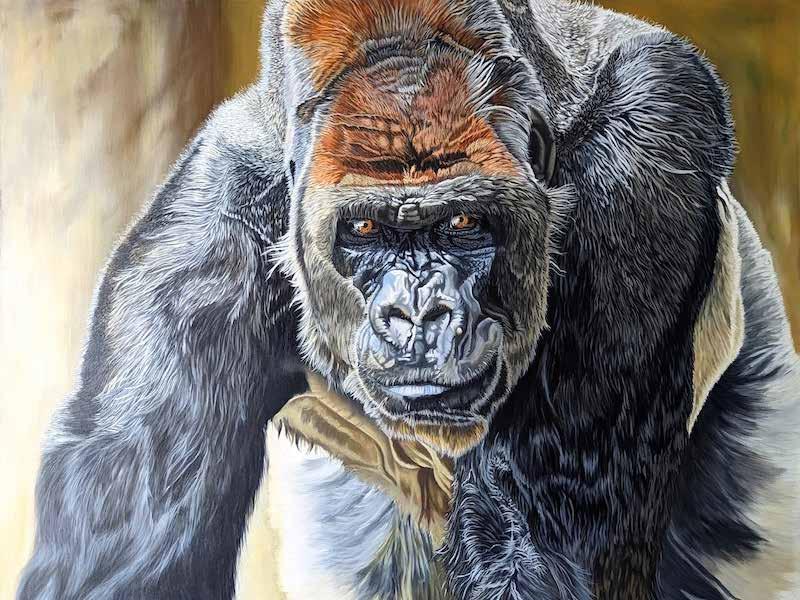
IIn a serene corner of the Phoenix Zoo, a massive gorilla gazes intently from a canvas, its expression captured in dramatic light and shadow. Nearby, a lifelike wolf stands sentinel against a snowy backdrop, rendered so perfectly in pastel that visitors mistake it for a photograph. These masterpieces aren’t just art — they’re ambassadors for conservation, part of a thoughtful program that’s changing how visitors engage with wildlife both global and local.
Art on the Wild Side, the Phoenix Zoo’s innovative art initiative, currently showcases two distinct exhibitions that invite visitors to view wildlife through fresh perspectives while supporting the zoo’s conservation mission.
“Our mission is to support animals and their habitats by providing experiences that inspire people to care about the natural world,” explains Jean Bingham, Art on the Wild Side Committee chair and Phoenix Zoo board trustee since 2008. “Like any organization, we’re always looking for ways to reach new people because conservation is so important to the Phoenix Zoo. It’s really the fundamental element of the zoo’s mission.”
The program’s centerpiece, “Society of Animal Artists Presents: A Boundless World,” transforms the Wild Side Gallery near the zoo’s entrance with works from an elite international collective of wildlife artists. Meanwhile, in the air-conditioned comfort of the Savanna Gallery (formerly Savanna Grill), “Arizona Urban Wildlife: Surviving a Complex World” explores the delicate balance between humans and local wildlife in our rapidly expanding urban environment.
“The art program offers multiple benefits,” Bingham says. “It brings new people to the zoo to see our beautiful artwork and helps us collaborate with artists in the community who then become interested in our conservation work. It helps us spread our message of conservation to new audiences while providing a more enriching experience for all our guests.”
The Society of Animal Artists exhibition features approximately 400 members whose work undergoes rigorous selection criteria. The society’s origins trace back to the Bronx Zoo in New York about 30 years ago, creating a natural synergy with the Phoenix Zoo’s mission.
“These are truly exceptional artists who specialize in depicting animals,” Bingham notes. “Their mission aligns perfectly with the zoo’s: getting people to care about the animal kingdom and their habitats, and inspiring action to help conserve them.”
The exhibition’s opening reception attracted 12 to 15 participating artists who traveled to Phoenix specifically for the event — impressive for an international group. Visitor response has been enthusiastic, with several pieces already sold. A percentage of all sales returns to the zoo, supporting its operations and conservation programs.
“The feedback I’ve received consistently highlights the exceptional quality of the artwork,” Bingham says, “which really reflects the Society of Animal Artists’ rigorous curation process for their membership.”
Among the standout pieces is “Bird in Hand” by Kim R. Diment, an oil painting of an ocelot spotted in Costa Rica.
“Her use of light in depicting the ocelot is remarkable,” Bingham describes. “There are feathers floating down that the ocelot is looking at, and the way the light shines on both the feathers and the ocelot, with greenery framing the scene, creates a captivating composition that draws viewers into this intimate wildlife moment.”
Equally impressive are the works showcasing extraordinary technical skill. “Passing By” by Lucrezia Bieler measures about 10 inches square and depicts a roadrunner running through prickly pear, crafted from a single piece of black paper on a white background.
“When you see it up close, you’ll be amazed that anyone could create such intricate art from a single piece of paper without making a single cutting mistake,” Bingham marvels.
Another cut-paper piece,“A Well-Behaved Beast” by Tiffany Miller Russell, features a multilayered, three-dimensional mandrill.
“The craftsmanship in these cut-paper works is simply amazing,” Bingham says.
This year’s exhibition continues the program’s recent inclusion of three-dimensional art, featuring 12 bronze sculptures displayed in the protected gallery space. “The Guardian” by Kim Chase — a huge gorilla portrait — commands attention for its dramatic use of light and striking contrast of dark and light tones. Meanwhile, “The Sentry” by Alex Fleming showcases a wolf against a snowy background, rendered with such precision in pastel that viewers often mistake it for a photograph.
Each artwork is accompanied by a caption card where artists share their inspiration — perhaps where they observed the animal or why it held significance — adding a personal depth to the viewing experience.
“We hope these artistic depictions help people fall in love with the creatures they’re seeing and inspire them to support the zoo through art purchases but more importantly, to care about these animals and their habitats. Jean Bingham

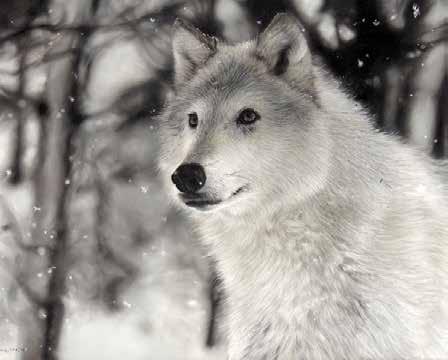
While “A Boundless World” presents global wildlife perspectives, “Arizona Urban Wildlife: Surviving a Complex World” hits closer to home, examining the complex relationship between humans and wildlife in our state’s expanding urban areas.
“What we’re trying to bring to our guests’ attention is how we’re really taking over many urban spaces that wildlife depends on,” Bingham explains. “We need to be sensitive to that and protective of those creatures living side by side with us in our backyards. We need to understand their needs and how they’re trying to survive alongside humans.”
The exhibition highlights conflicts and coexistence — from coyotes entering backyards to birds striking buildings — and emphasizes Arizona’s crucial role as a migration corridor along the Western Hemisphere from South America to Alaska.
“Our artists have depicted these relationships — some quite whimsically,” Bingham says. “We have beautiful photography of coyotes in drainage pipes and eagles sitting on light poles and similar urban perches. These are wonderful scenes we’ll encounter right where we live. We hope people will appreciate and care about that wildlife and take action to help protect it.”
Among the urban wildlife exhibition’s highlights is “Jamaal Amidst the Washingtonia Filiferas” by Deborah Cassolis, a large painting selected through a juried call for submissions.
“You might not think of a camel as urban wildlife,” Bingham notes, “but Arizona actually has a fascinating history with these animals. They were brought here more than 100 years ago to serve as pack animals across the desert. When they became difficult to manage, many were released into the wild.”
The exhibition also features striking depictions of birds and coyotes navigating urban environments. One particularly memorable painting shows a coyote standing atop a car, while others depict the animals peeking around buildings. Photographs of hawks and eagles perched on telephone poles and streetlights further illustrate wildlife adaptation to human infrastructure.


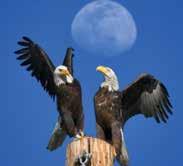
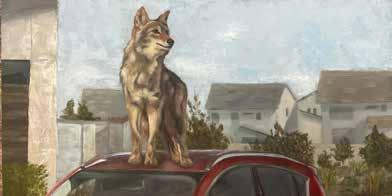




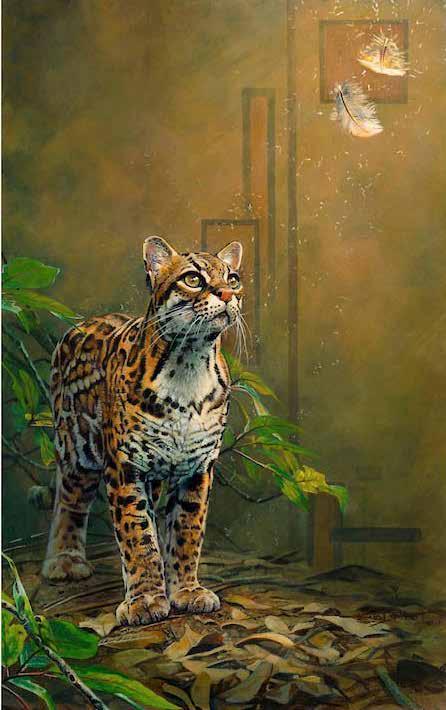

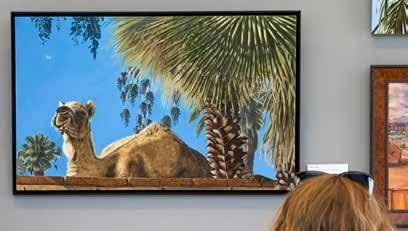

Beyond their artistic merit, these exhibitions enhance the overall zoo experience by offering moments of reflection and respite.
“I have a good friend who has grandchildren, and she comes to the zoo all the time,” Bingham shares. “She absolutely loves going into the Wild Side Gallery because it’s a quiet, cool, restful space.”
The gallery includes engagement activities for children, including drawing opportunities and a display wall for their artwork.
“When you come to the zoo, it’s a very sensory experience,” Bingham explains. “You use your eyes, your nose, your ears. In some cases, you can use touch and experience the animals in their very natural-looking habitats. Then you can come over to the gallery and have a little quiet time, a little respite.”
Similarly, the Savanna Gallery transforms dining into an art experience.
“Having your lunch surrounded by beautiful artwork as opposed to just blank walls, which were there before we started this program six years ago, creates a more enriching experience,” Bingham notes. “We’ve observed children going through the grill and choosing the table they want to sit at based on what art is hanging above it. The kids are really getting into it, which thrills us because conservationists are developed young, and if the artwork helps with that, all the better.”
Bingham’s passion for the program stems from her longstanding connection to the Phoenix Zoo. A member since 1988, she maintained her membership through a 20year absence from Arizona, returning to serve on the board of trustees in 2008.
“My passions are centered around the animal world, their habitats and preserving those habitats in the wild,” she explains. “I’m truly inspired by and in love with the entire
animal kingdom. This program offers something different. We have a great committee of talented people — artists, photographers and other volunteers—who work with zoo staff to produce these wonderful exhibits.”
The art program coincides with exciting developments at the Phoenix Zoo, including the opening of the Big Cats of Arizona exhibit.
“That’s a brand-new home for our jaguars and mountain lion, including a pathway over the top of the visitor trail,” Bingham enthuses. “You might have the opportunity to walk underneath a jaguar while it’s crossing overhead!”
The zoo also recently opened Predator Passage, a new Africa exhibit featuring lions, hyenas, a leopard, vultures, fennec foxes and meerkats. The Wild Side Gallery itself represents adaptive reuse at its finest — a refurbished mid-century modern building that previously served as an off-campus utility structure, now transformed into the art program’s centerpiece.
“I think with our mission of caring for these animals and hoping to inspire people to care about them too — by having the animals on exhibit so people can see them and fall in love with them, plus that added element of beautiful artwork depicting them in their habitats — it creates a really great, well-rounded experience when you visit the Phoenix Zoo,” Bingham reflects.
Through Art on the Wild Side, the Phoenix Zoo offers a unique opportunity to connect with wildlife on multiple levels — observing real animals in thoughtfully designed habitats, then experiencing artistic interpretations that might reveal different dimensions of these creatures’ existence. In the process, visitors gain a deeper appreciation for both art and wildlife conservation, carrying that awareness beyond the zoo’s boundaries and into their daily lives.
phoenixzoo.org
Society of Animal Artists Presents: A Boundless World
Through May 25 // Thursday–Sunday // 9 a.m.–1 p.m. // Wild Side Gallery
Arizona Urban Wildlife: Surviving a Complex World
Through June 29 // Daily // 9 a.m.–5 p.m. // Savanna Gallery
Phoenix Zoo
AA lathe spins at a dizzying pace and wood shavings fly as artist Brian Lensink leans in with a gouge tool, his steady hands refining what will eventually emerge as a stunning work of art. In his Phoenix studio, Lensink’s awardwinning work is the visually inventive, handhewn manifestation of his lifetime of creativity, building and problem-solving.
While he began his woodturning journey by creating items most associated with the craft — bowls and open vessels rich in the natural beauty of wood grain, sapwood and bark, smooth and luminous, cracks filled with turquoise and copper or carved and brightly painted — Lensink’s current iterations are imbued with form, shape and pattern that feel ancient, innovative, and timeless all at once.
It’s hard to believe he has developed this awardwinning level of talent within just over a decade and has continued to innovate, now teaching and inspiring others as past president and active member of the Arizona Woodturners Association.
The artisan within him was always there, but sometimes the pressure of career and time constraints have to fall away before an artist’s true calling can emerge.
“Working with my hands is something I’ve always enjoyed,” Lensink notes. “I doublemajored in industrial arts education and special education at the University of Minnesota and planned to become a shop teacher.”

I’ve always been a problem solver and a builder, whether it was developing creative approaches to working with people with disabilities or woodturning; I’ve always been interested in creating — whether it be systems of care or works of art.
Brian Lensink

A pre-senior year summer internship with one of his professors at a sheltered workshop for individuals with developmental disabilities significantly altered his career path. He soon found himself pioneering a similar program at the University of Nebraska and later helped to overhaul the centralized intellectual developmental disabilities institution systems of multiple states in favor of establishing a network of small, community-based support networks and regional centers.
Eventually, this professional sphere brought him and his wife, Barbara, to Arizona, where she still works in developmental disability services through employment with the University of Arizona.
His rewarding and crucial work enhanced the lives and futures of hundreds of thousands of individuals with developmental disabilities and their families but left little room for serious artistic pursuits.
“Throughout my career, I was always interested in artistic things but didn’t have a lot of time,” Lensink observes. “My avocation was making mobiles, and I sold them in galleries. I was fascinated by the work of American sculptor Alexander Calder. During this period, the mobiles were all made from aluminum and wire.”
Lensink’s true artistic calling and ability to dedicate himself to its development remained unfulfilled until his retirement in 2012, when a chance invitation by a fellow pickleball player to participate in the recreation center’s wood shop would ignite his passion for woodturning.
“I fell in love with the lathe,” he recalls. “I had never done woodturning until that year. It became a real interest and fascination for me. It takes time to learn, but there’s always something new you can do if you push yourself.
“You can turn a wooden bowl, but then you can go so much further. You can love the natural wood but get into wood carving and then add color — airbrush, painting and dyeing wood. Each time it expands your ability.”


Lensink’s innate talent for the art form began to grow as he amassed tools and set up his own wood shop in his threecar garage.
“As you’re learning, you learn about wood, the heartwood at the center, the sapwood — whose width varies with the speed of the tree’s growth — and the bark on the outside,” he explains.
One of his favorite woods to work with found in Arizona is African sumac, but these trees are few and far between, and the process to dry and process any wood from a harvested fallen tree to a finished piece is long and sometimes unpredictable. A log for a large salad bowl can weigh hundreds of pounds, only for most of that precious natural beauty to fall to the floor in rough piles of shavings.
Among his favorite woods are African wenge and yellowheart, which don’t exist in Arizona but can be procured from specialty purveyors. Cream-colored spalted tamarind from Southeast Asia and Africa is another exotic material with a distinct appearance that Lensink uses to great effect; when a tree falls, bugs create tiny holes in the sapwood and bacteria proliferate, creating dark grain markings — almost like the effect in an aged blue cheese. Once the wood is cut and dried, the effect is halted but the spalting remains.
Lensink discovered that by creating segmented turnings made from lumber — woodturning projects constructed from multiple pieces of wood glued together — he could purchase a broad array of wood ready to be shaped into whatever his skill and imagination could create.
He cuts the boards into angled segments, lays them out with the wood grain all running in the same direction, numbers each piece and glues them into rings. Connecting several rings at a time, they are fastened to the lathe, and he begins to shape a smooth, even form inside and out, allowing the finished piece to be hollow and lighter in weight.
“If you don’t create a pleasing design or form, it will not look good even if your turning technique is excellent. There is no substitute for good form,” he notes.
But imprecision isn’t in Lensink’s lexicon.
He adds rings as he goes, then shapes the bottom half before bringing the two halves together.
“I can vary the wood within each segment,” Lensink notes. “The method expands your design capabilities dramatically;





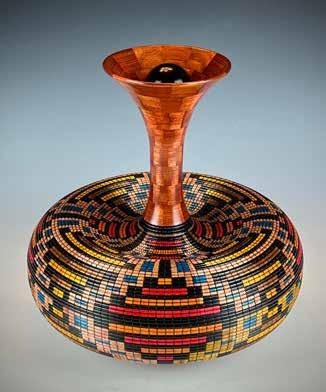

you can use more than one kind of wood in a single finished piece and alternate in any way you want — the colors can vary in a ring, in colors between rings, or colors between rings. It’s how you put them together.”
For a “basket illusion” piece — a design first inspired by Native American pottery and baskets but now also inspired by his own imagination — he cuts a bead into the smoothed form for a precise rippled effect. This becomes a canvas for mesmerizing color and pattern. He painstakingly burns vertical lines into the piece, bead by bead with a 1/8-inch or 3/16-inch concave tip, then burns it horizontally on the lathe. Line by line, the effect appears to be individual beads — thousands of little squares ready for color.
Lensink uses Adobe Illustrator to create a grid and plot out his intricate designs, then uses an India ink pen to color each bead. The ink is archival, waterproof and lightfast — resistant to fading in sunlight, which is of great importance to collectors here in the desert.
He finishes each work of art by applying five to six coats of clear lacquer to the exterior. For other pieces, he uses petroleum-free and food-safe Osmo, which contains natural oils and waxes.
“People say, ‘That looks time-consuming,’ and I say, ‘Yes, it is!’” he says with a soft laugh. “Burning line by line takes a lot of time, then working out my design and coloring in thousands of beads. It can take weeks.”
Lensink is constantly inspired by items he sees in museums, art books, magazines and encounters on his travels. In addition to basket illusion pieces, Lensink has created Japanese flower baskets, which are normally fashioned from reeds, and has used a small dental drill to create pieces that are pierced in patterns between airbrushed images that stand out in relief from the piercings. Ultimately, his goal is to create his own ideas and interpretations that are unique to him.
“I’m trying to create works that are my creations, not anyone else’s,” he says with a smile.
Despite the labor- and time-intensive nature of his art, Lensink has been prolific in his work and all its forms. Choosing a favorite piece is tough, but he says his favorite is usually whatever he had most recently completed.
“I always try to do something new and different,” he says. “It may be in shape or form, different wood combinations or in the size of the piece.”
As he constantly stretches his own limits, the 78-year-old pushes himself to innovate and master each technique that intrigues him. When he looks to the future of woodturning, he believes there is plenty more on the horizon.
“I think there will be new techniques that evolve that we don’t really know about right now,” he observes. “I think that a combination of techniques will be used more, including piercing, segmenting, carving and coloring. I’m thinking about that for myself.”
Every museum visit, page turned through a wood-sourcing catalog or afternoon in the shop is a chance to deepen his knowledge, technique and artistic expression.

“I’ve always been a problem solver and a builder, whether it was developing creative approaches to working with people with disabilities or this [woodturning]; I’ve always been interested in creating — whether it be systems of care or works of art,” he says.
The depth of Lensink’s artistic vision and technical mastery will be on full display during a special showcase Thursday, April 17, from 4 to 7 p.m. at Grace Renee Gallery in Carefree’s Historic Spanish Village. Collectors and art enthusiasts will have the opportunity to meet Lensink and gain insight into his creative process while experiencing his remarkable works in person while enjoying wine and appetizers.
“The brilliant hues of intricate patterns on Brian’s pieces reflect the mosaic of desert beauty that surrounds us,” says Shelly Spence, owner and curator of Grace Renee Gallery.
“The unparalleled artistry and rich detail make each work a dramatic statement in itself. We are thrilled to feature art
of this caliber, and our patrons will certainly feel the same excitement when they see it in person.”
For Lensink, this upcoming exhibition represents not just a showcase of his current mastery but a milestone in an artistic journey that continues to evolve.
As his hands transform exotic woods into objects of beauty and wonder, his innovative spirit ensures that each new creation will surpass the last — a testament to the power of discovering one’s true calling, even if that discovery comes later in life. His singular works, born from a lifetime of problem solving and creativity, now find their rightful place in the collections of those who recognize exceptional artistry when they see it.
gracereneegallery.com

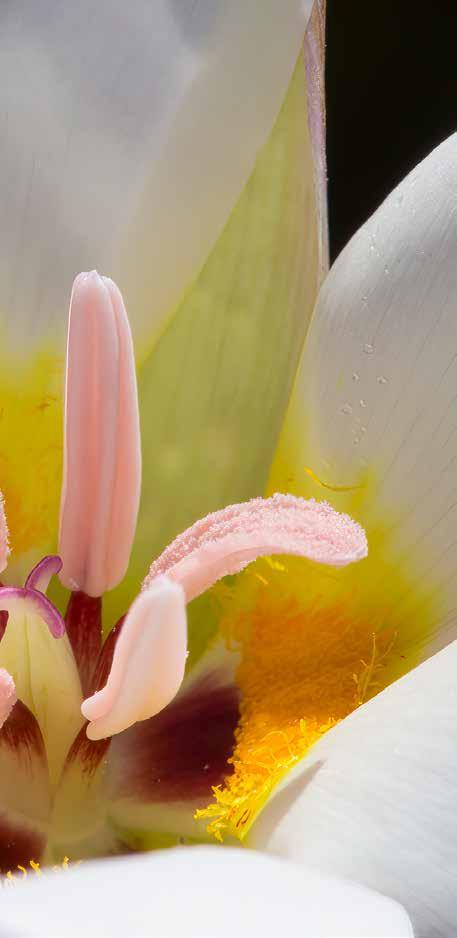
Writer Joseph J. Airdo // Photography by Paul Gill
IIn the sprawling Sonoran Desert, where towering saguaros command attention and dramatic mountain ranges pierce the horizon, photographer Paul Gill has spent decades discovering universes that exist in spaces smaller than a penny. Through his macro lens, a single dewdrop becomes a crystalline sphere reflecting entire worlds, while the delicate stamens of a spring wildflower transform into an abstract sculpture of color and light.
“With all the noise that we are constantly confronted with daily, I find serenity by slowing down and noticing the small things that surround me in nature,” says Gill, his words carrying special weight as Earth Day 2025 approaches.
These images serve as intimate reminders that environmental conservation starts with understanding — and appreciating — life at its most fundamental level. Each photograph represents hours of patient observation and technical precision.
“Setting up a macro image can take hours,” Gill explains. “After finding my subject and locating a spot to sit on the desert floor without getting poked, stung or bitten, I set up my camera on a tripod and compose my shot.”
This methodical approach involves carefully diffusing harsh sunlight and reflecting it back onto subjects that most hikers pass without a second glance. The results are nothing short of revelatory — especially as we consider our role as stewards of the natural world.
Through Gill’s lens, we witness the intricate architecture of native insects, the jewel-like quality of morning dew and the abstract patterns hidden within desert flora. Each image serves as both art and advocacy, highlighting the complexity and fragility of ecosystems that depend on our protection.

A wild onion’s delicate bloom emerges alongside the flat pad of an Engelmann’s prickly pear along the Barnhardt Trail in the Mazatzal Mountains. This unlikely pairing — the soft, spherical flower beside the armed, succulent surface — illustrates the remarkable diversity of survival strategies that allow plants to thrive in Arizona’s challenging mountain ecosystems.

A Santa Rita prickly pear (Opuntia gosseliniana) displays its emerging flower bud alongside a young pad at Boyce Thompson Arboretum. Unlike its cousins, this distinctive native species features pads with a purplepink hue — a natural adaptation that helps protect it from intense desert sun while adding a splash of color to Arizona’s arid landscape.
With all the noise that we are constantly confronted with daily, I find serenity by slowing down and noticing the small things that surround me in nature. Paul Gill “
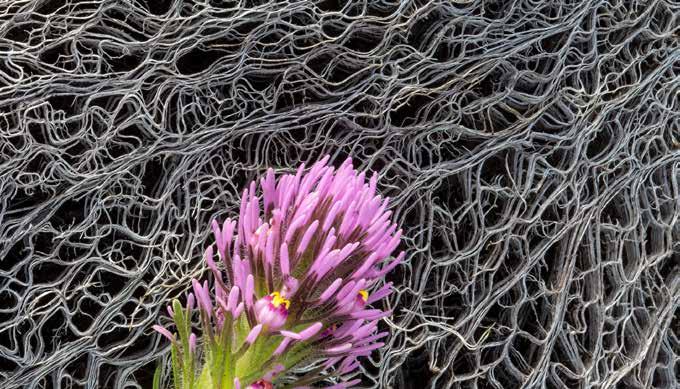

The strawberry hedgehog cactus (Echinocereus engelmannii) displays its spectacular magenta blooms in perfect spring timing. These vibrant flowers, with their distinctive dark green stigmas, transform the desert into a canvas of color each April and May. Growing in clustered communities of up to 20 stems, these native cacti create miniature ecosystems that support a variety of desert wildlife with their eventual spiny fruits.
“The way I create on a small scale is with the ‘art of subtraction’ — taking all the things in view and removing elements until I concentrate on just one thing or group of things that have a noticeable aesthetic quality. Paul Gill

Morning dew transforms a Mexican golden poppy into a gallery of miniature worlds west of Bartlett Lake, with each droplet refracting the image of a nearby saguaro cactus. This magical intersection of Arizona’s iconic flora, captured through macro photography, reveals how the grand and minute elements of the Sonoran Desert exist in perfect harmony.

A Mojave prickly poppy (Argemone corymbosa), commonly known as the “cowboy fried egg” flower, displays its distinctive four white petals and vibrant orange center along the Spur Cross Trail. This perennial native to the southwestern United States thrives in sandy soils and on dry slopes throughout Arizona’s desert landscape.
A chance encounter between a banana yucca and nodding thistle bloom creates a spectacular botanical embrace on Black Mesa in the Mazatzal Mountains. The yucca, bent from the weight of its own flowering stalk, and the thistle, reaching skyward to its potential 6-foot height, demonstrate how wildly different desert species can intertwine in unexpected moments of natural harmony.

“Taking a closer look goes beyond capturing ordinary pictures; it reveals the extraordinary details that often are overlooked due to their size. Paul Gill
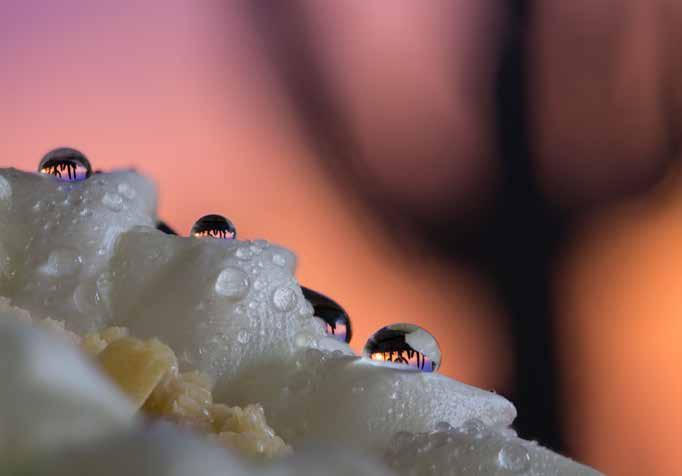
Raindrops cling to a saguaro bloom at sunrise in Box O’ Wash near Price, each tiny sphere refracting images of the distant sun and surrounding desert. This ephemeral moment—where water, light, and Arizona’s iconic cactus converge — illustrates how macro photography can reveal entire landscapes within spaces smaller than a fingertip.

For Paul Gill, Arizona’s landscape isn’t just a subject — it’s home. Born in the Valley of the Sun in the 1950s, Gill’s connection to the Sonoran Desert was forged during childhood adventures that would later inform his artistic vision.
“I grew up in the Sonoran Desert, where I was first inspired by the desert light and local nature, which remain the prime subjects of most of my work,” Gill reflects.
After earning his BFA in graphic design and painting from Arizona State University, Gill spent 17 years as an art director, including a notable tenure at the Scottsdale Center for the Arts. There, he designed and produced exhibitions including Frank Lloyd Wright’s “In the Realm of Ideas” and an international art show addressing world hunger.
Today, Gill’s work appears regularly in Arizona Highways magazine and calendars, while his photographs grace the walls of the Arizona State Capitol, State Farm Stadium and the Smithsonian’s permanent collection. He co-authored the awardwinning book “Wild in Arizona: Photographing Arizona’s Wildflowers, A Guide to When, Where, and How,” and his images have been featured in National Geographic and Nature’s Best
Yet despite these accolades, Gill remains devoted to his primary mission: revealing the extraordinary in the ordinary. Through workshops and presentations at venues like the Desert Botanical Garden and the Nature Conservancy, he shares not just his technical expertise but his philosophy of mindful observation — a reminder that nature’s greatest mysteries often exist right at our feet. paulgillphoto.com wildinarizona.com

A delicate morning dewdrop clings to the stamen of a desert golden poppy, creating a natural lens that refracts the image of a nearby cosmos flower. This moment of ephemeral beauty, captured in the early dawn light, reveals how even the smallest elements of nature can contain reflections of the larger world around them.

The fishhook cactus reveals its intricate defense system of curved, barbed spines that give this small desert dweller its descriptive name. Though often confused with its larger cousin, the fishhook barrel cactus, these diminutive plants (reaching only 6-7 inches high) from the Mammillaria, Echinomastus or Sclerocactus genera demonstrate how macro photography can transform intimidating protection mechanisms into objects of geometric wonder.

The iconic bar at Durant's has played host to countless business deals and celebrations since 1950, embodying the establishment's reputation as “the finest eating and drinking establishment in the world.”
TThrough the kitchen entrance they’ve come for 75 years — celebrities, politicians, powerbrokers and everyday Phoenicians celebrating life’s milestones.
Now, a new chapter begins as one of Arizona’s most venerable dining institutions passes to new stewards committed to honoring its storied past.
James Beard-nominated brothers Mike and Jeffrey Mastro, along with their father, Dennis Mastro, and business partner Scott Troilo, have purchased Durant’s, the Central Avenue landmark that has served steaks, seafood and martinis in its signature red velvet setting since 1950.
“To loosely quote Patek Philippe, you never own a legend like Durant’s; you simply look after it for the next generation,” Mike says. “My family and I are thrilled with the acquisition and intend to bring a renaissance to this iconic steakhouse and expand its legendary status for generations to come.”
For longtime patrons who might worry about changes to their beloved institution, Jeffrey offers reassurance.
Writer Joseph J. Airdo
“We’ll preserve the iconic kitchen entrance, of course, and the classic period look and feel of the legendary dining room and bar,” he explains. “This restaurant brand is a part of Arizona’s history, and it will look and feel as it always has — comfortable and familiar, yet upscale and timeless.”
The sale marks a significant transition for Durant’s, which had remained under the same family ownership since Jack Durant and Jack R. McElroy (along with Durant’s four-legged “buddies,” Humble and Socrates) opened their small steakhouse on Central Avenue in 1950.
“It has been the honor and pleasure of a lifetime to serve the finest steaks, perfect martinis and heavenly desserts to our extended Durant’s Arizona ‘family’ for the past 75 years,” say Jack M. and Carol McElroy, the second-generation owners who have stewarded the restaurant for decades.
The McElroys express confidence in the new ownership, noting the restaurant will be “led by the extraordinary Mastro family and its highly skilled team of restaurateurs.”
To loosely quote Patek Philippe, you never own a legend like Durant’s; you simply look after it for the next generation. Mike Mastro

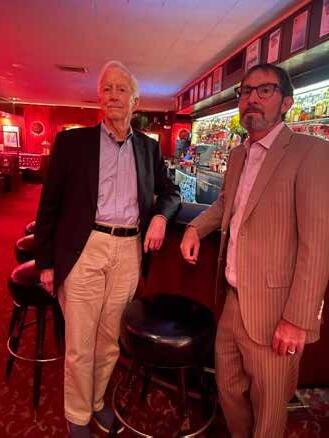
The Mastro brothers bring impressive credentials to their newest acquisition. They own and operate Dominick’s Steakhouse, Steak 44 and Ocean 44 in the Valley, plus Steak 48 and Ocean 48 in cities including Chicago, Houston, Charlotte, Philadelphia and Beverly Hills.
“It’s a privilege and honor to acquire the restaurant and to preserve its history, while enhancing its future for generations to come,” Jeffrey says.
Durant’s will temporarily close for kitchen renovations while preserving the dining room’s iconic ambiance. When it reopens, diners can expect the same familiar atmosphere with subtle enhancements.
“Our intention with Durant’s is to enhance, not change,” Jeffrey emphasizes. “Our most impactful influence will be bringing the luxury, personal service we’re known for at Steak 44, Ocean 44, and Dominick’s Steakhouse to Durant’s dining room, along with elevating the food quality while honoring the classic menu.”
The acquisition has already yielded community benefits. In late February, the Mastro brothers — both Brophy Prep alumni — enlisted their alma mater to help deliver a truckload of Durant’s nonperishable food staples to St. Vincent de Paul.
“As my brother Mike and I and our family get ready for a renaissance of the legendary brand of Durant’s, we couldn’t be prouder to make a significant and life-changing donation to St. Vincent de Paul,” Jeffrey says. “We know this truckload of nonperishable food staples will go a long way in helping the people of Phoenix who need it the most.”
For generations of Phoenicians who have celebrated anniversaries, closed business deals or simply enjoyed a perfectly crafted martini at Durant’s, the restaurant’s future appears secure in the hands of restaurateurs who understand both tradition and excellence.
As the McElroys note, under the Mastros’ leadership and “with the support of the Durant’s community that has walked through the famous backdoor for the last 75 years,” they are confident that Jack Durant’s self-proclaimed “finest eating and drinking establishment in the world” will continue to be a place of celebration.
durantsaz.com

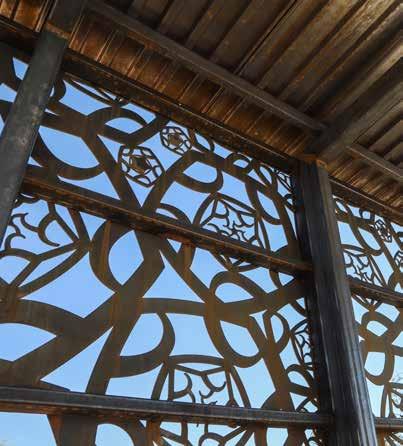
IIn North Scottsdale’s Ashler Hills Park, something remarkable has taken root. Five perforated steel panels cast intricate shadows across pickleball and basketball courts, transforming what could have been ordinary shade structures into an extraordinary artistic experience.
This is “Potentilla,” the northernmost installation in the Scottsdale Public Art Permanent Collection, created by Arizona-based artist Mary Bates Neubauer. The artwork represents a perfect marriage of form and function, cultural heritage and environmental adaptation.
“I wanted to create an artwork that tied in stylistically with the other public artworks I’ve completed in Arizona over the past 25 years, where I’ve utilized desert flora and fauna motifs and silhouettes,” Neubauer says. “For this larger project at Ashler Hills Park, I wanted the repeating designs to be more complex, rhythmic, and abstract.”
This isn’t Neubauer’s first contribution to Scottsdale’s public art landscape. She previously created “Traceries,” a series of eight side-by-side metal recycle/waste bins for the Scottsdale Waterfront area in Old Town. Throughout her career, she has completed more than 30 public artworks across the U.S. and Italy.
Named after the Arizona cinquefoil, a resilient native plant featuring five-petaled blossoms, the installation draws inspiration from both local ecology and distant architectural traditions.
I wanted to create a design that allowed enough negative space for desert breezes to blow. The resulting patterns are soft and curvilinear yet retain a brisk, lively contemporary look. Mary Bates Neubauer
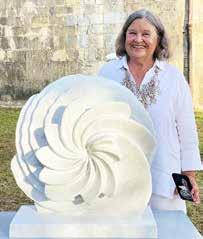
“You could call me a ‘pattern detective’!” Neubauer explains. “I developed numerous designs based on four-, five-, six- and seven-sided symmetries, ultimately gravitating toward the oddnumbered symmetries as more interesting and unusual.”
This exploration led Neubauer to the potentilla plant, which she admired for “its simplicity, stalwart hardiness and wide geographical range, even in extreme climates. There’s even a variant that thrives in the Arctic — like the desert, another extreme environment!”
The installation consists of five exterior artistic panels, each measuring 10 by 20 feet, attached to shade canopies near the lighted courts. The intricate patterns were designed using Rhino 3D, a versatile computer modeling program that allowed Neubauer to abstract, simplify and rotate the flower’s silhouettes at varying scales.
Beyond local flora, Neubauer found inspiration in architectural elements from halfway around the world.
“I was particularly inspired by the jali screens at the Red Fort in Delhi,” she says, referencing the perforated stone screens found throughout Mughal architecture. “These decorative screens use nonmechanical means to create cooling outdoor environments in a way that’s both commonsense and beautiful. My vision was to create a place where people could sit, rest and stay cool by finding the perfect balance between breeze and shade.”
This cross-cultural approach to design reflects the artist’s fascination with mathematical patterns in nature. Rather than focusing on narrative illustration, Neubauer finds joy in “responding to the mathematical structures that underlie what we see.”
Crafted from Cor-Ten steel, the panels will evolve over time as they naturally rust, developing warm, earthy tones that deepen
with age. This specialized “weathering steel” creates what Neubauer describes as a “gradually thickening layer of velvety iron oxide” that protects the underlying metal.
“It’s challenging to find sculptural materials that hold up well outdoors, especially here in the desert!” she notes. “CorTen was the material solution that would both complement the architectural style of the entire site and provide structural integrity for the long run.”
The fabrication process involved collaboration with Phoenixbased manufacturer Magnum Engineering, which laser-cut and sandblasted the quarter-inch steel plates. The installation required specialized equipment, including a spider crane and four crew members, to safely elevate and secure the panels to the shade structures.
For Scottsdale Public Art, “Potentilla” represents a significant expansion of the city’s renowned public art program into its northern communities.
“‘Potentilla’ exemplifies Scottsdale Public Art’s mission by seamlessly blending art and function at Ashler Hills Park,” says Kati Ballares, director of public art for Scottsdale Arts. “As the northernmost installation, it reflects Scottsdale’s commitment to expanding public art citywide.”
The project, supported by the city’s percent-for-art ordinance, highlights “Scottsdale’s more than 50-year dedication to placemaking, urban design, and fostering a nationally recognized, community-driven public art program,” Ballares adds.
As temperatures rise and spring activities draw residents to Ashler Hills Park, “Potentilla” offers not just practical shade but an opportunity to experience how art can transform everyday spaces. The installation demonstrates how functional elements in public spaces can be elevated to create meaningful cultural experiences.
For North Scottsdale residents, this artful addition to their recreational space serves as a reminder of the community’s connection to both the natural environment and the broader artistic heritage that defines Scottsdale as a whole.

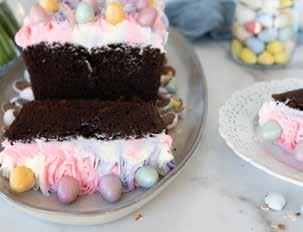
Writer and Photographer Francine Coles
Spring’s arrival heralds not only the emergence of daffodils but also the perfect occasion for this sophisticated Easter egg chocolate loaf. This visually stunning dessert transforms the holiday table with its artful presentation and rich, indulgent flavor profile. While elegant enough for discerning guests, this celebratory creation also offers an engaging culinary project to share with younger family members.
1 loaf cake (serves 12)
Ingredients:
For the Chocolate Loaf Cake:
1 1/2 cups granulated sugar 1/2 cup butter, softened 3/4 teaspoon salt 2 teaspoons vanilla extract
1 teaspoon baking soda 1/4 teaspoon baking powder
2/3 cup unsweetened cocoa powder 3 large eggs
1 1/4 cups all-purpose flour 3/4 cup milk
For the Buttercream:
1/2 cup unsalted butter, room temperature
1 cup powdered sugar 1/2 tablespoon heavy cream or milk
1 teaspoon pure vanilla extract Purple and pink food coloring
8–10 ounces mini eggs, for decoration 4 disposable pastry bags
2D closed-star piping tip
Directions:
For the chocolate loaf cake: Preheat the oven to 350 degrees. Grease and flour a 9-by-5-by-3-inch loaf pan or spray with a baking spray that includes flour.
In a stand mixer, beat sugar and butter together until well blended. With the mixer on low speed, add the salt, vanilla extract, baking soda, baking powder and cocoa powder. Mix until blended. Add the eggs, one at a time, beating well after each addition.
Add about 1/3 of the flour and 1/2 of the milk and mix on low speed until combined. Add another 1/3 of the flour and the remaining milk and mix thoroughly. Add the remaining flour and combine all ingredients, being careful not to overbeat the batter. Pour the batter into the prepared loaf pan and spread evenly.
Bake for 60 to 65 minutes or until a toothpick inserted in the center of the loaf comes out clean. Cool in the pan on a rack for about 10 minutes.
Carefully remove the cake from the pan and cool completely on a rack.
For the buttercream: Beat the butter on its own for a few minutes to loosen and make it smooth. Add in the powdered sugar and beat again. If necessary, add 1 tablespoon at a time of cream or milk so that it is smooth and workable. Don’t let the buttercream become too runny by adding too much cream. Add the vanilla and beat again.
Equally divide the buttercream into three bowls. To one bowl, add a drop of pink gel color to create a pastel pink buttercream. To the second bowl, add a drop of purple gel color to create a pastel purple buttercream. Leave the third bowl uncolored for a classic white buttercream.
Fit one disposable pastry bag with the piping tip. Fill the other three with the different colors of buttercream. Once filled, cut a 1/2-inch opening in the bottom of each bag. Take all three buttercream bags and evenly place them inside of the fourth bag that is fitted with the tip. With even pressure, start piping inch-wide back-and-forth squiggles. Continue until the top of the cake is covered. Add mini eggs to the top.
Serve immediately or store in an airtight container for up to three days.

